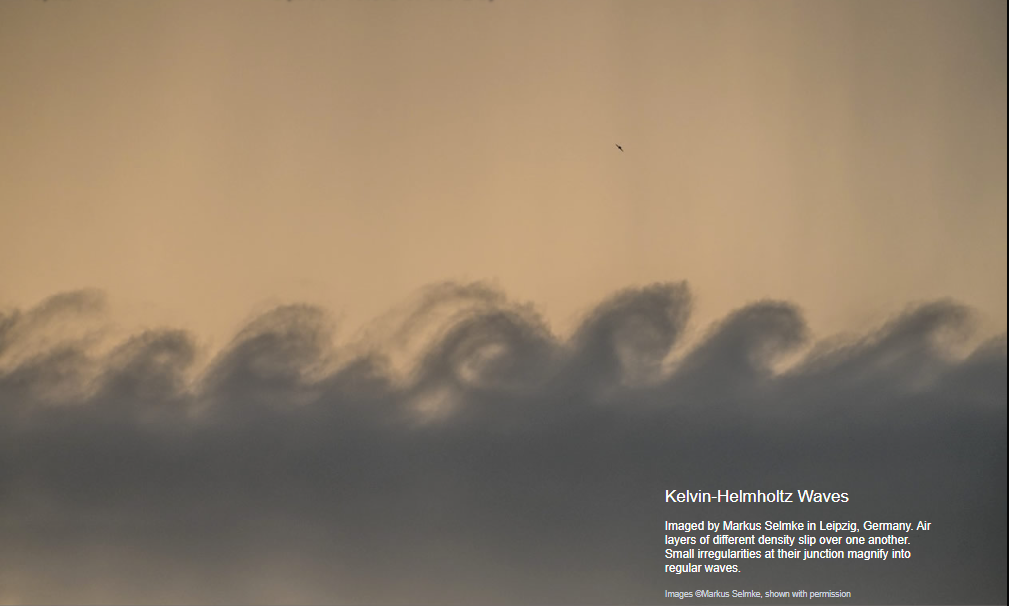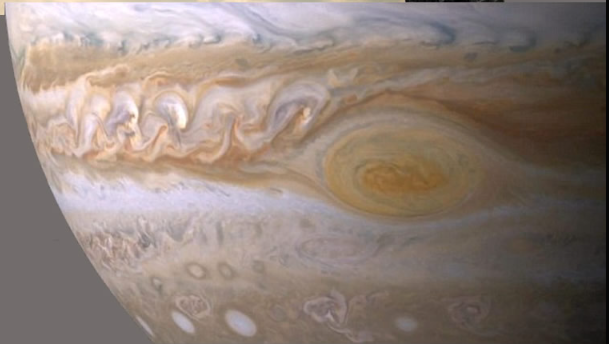Kelvin-Helmholtz Instabilities - OPOD
Kelvin-Helmholtz Instabilities: Unveiling the Secrets of Atmospheric Waves
Atmospheric phenomena never cease to amaze us with their captivating beauty and intricate mechanisms. One such phenomenon is the Kelvin-Helmholtz instability, which manifests as mesmerizing wave-like patterns in the sky. These waves occur when two fluid layers, such as air masses of different temperatures and densities, slide past each other at different speeds. However, the Kelvin-Helmholtz instability is not limited to the atmosphere; it can also be observed in oceans and even on distant celestial bodies like Jupiter.
The formation of Kelvin-Helmholtz waves can be visualized as irregularities at the interface between the two fluid layers magnifying into regular waves. As the faster-moving upper layer glides over the slower-moving lower layer, small hills and depressions begin to develop at their junction. This situation bears some resemblance to the flow over an aircraft wing. The net pressure exerted by the fluids passing over the hills is directed upwards, causing the hills to grow. Conversely, depressions are forced downwards. Over time, these irregularities evolve and roll up, ultimately transforming into mature Kelvin-Helmholtz waves.
Beyond their aesthetic appeal, Kelvin-Helmholtz instabilities play a crucial role in the exchange of momentum and energy between different components of Earth's system. In the atmosphere, these waves contribute to the transfer of energy and momentum between air layers of varying characteristics. Similarly, in the oceans, Kelvin-Helmholtz instabilities facilitate the exchange of energy and momentum between layers of different densities. By unraveling the dynamics of these waves, scientists gain valuable insights into the complex interactions that shape our planet.
Kelvin-Helmholtz instabilities are not confined to Earth alone. These wave-like patterns can also be observed on Jupiter, where they span tens of thousands of miles between distinct cloud belts. The immense size of these Kelvin-Helmholtz waves on Jupiter underscores the universal nature of this phenomenon. By studying these planetary-scale instabilities, scientists gain a broader understanding of the dynamics and behavior of fluids in extreme environments.
In Leipzig, Germany, Markus Selmke captured stunning images of Kelvin-Helmholtz waves as air layers of different densities slipped past each other. These photographs showcase the intricate details and mesmerizing patterns that arise from the interaction of fluid layers. Additionally, Selmke's images also provide a visual reminder of the delicate balance between forces that govern the formation and evolution of Kelvin-Helmholtz instabilities.
The exploration of Kelvin-Helmholtz instabilities is an ongoing endeavor, with researchers striving to uncover the underlying mechanisms that drive these waves. By combining observational data, laboratory experiments, and numerical simulations, scientists are piecing together a comprehensive picture of this atmospheric phenomenon. Their efforts not only deepen our understanding of Earth's atmosphere but also have practical implications for fields such as meteorology, climate science, and fluid dynamics.
In conclusion, Kelvin-Helmholtz instabilities are captivating manifestations of fluid dynamics that occur when two fluid layers slide past each other at different speeds. These wave-like patterns can be observed in the atmosphere, oceans, and even on distant planets like Jupiter. Through their study, scientists gain valuable insights into the exchange of energy and momentum within Earth's system. As our understanding of Kelvin-Helmholtz instabilities grows, so too does our appreciation for the intricate interplay of forces that shape our world.

Kelvin-Helmholtz Waves
Imaged by Markus Selmke in Leipzig, Germany. Air layers of different density slip over one another. Small irregularities at their junction magnify into regular waves.
Images ©Markus Selmke, shown with permission

Kelvin-Helmholtz instability waves can arise when two fluids are travelling at different speeds.
The fluids can be, as here, air layers at different temperature and density with the upper layer moving faster. They can be layers of different density inside the oceans. They can be the sea surface and the windy air above. They can be swiftly moving belts on mighty Jupiter.
Under some circumstances the layers’ interface becomes unstable. Imagine a small hill forming. The situation then has some similarity to flow over an aircraft wing. The net pressure produced by the two fluids moving past the hill is upwards (Bernoulli effect) causing the hill to grow. Similarly, a depression is forced downwards. Irregularities grow, they then roll up to become mature Kelvin-Helmholtz waves.
As well as forming rare and beautiful clouds, Kelvin-Helmholtz instabilities are of major importance in the transfer of momentum and energy between the atmosphere and oceans.

K - H waves and Peterskirche, Leipzig.

K - H waves tens of thousands of miles across between different velocity cloud belts on Jupiter. Image courtesy NASA
Note: this article has been automatically converted from the old site and may not appear as intended. You can find the original article here.
Reference Atmospheric Optics
If you use any of the definitions, information, or data presented on Atmospheric Optics, please copy the link or reference below to properly credit us as the reference source. Thank you!
-
<a href="https://atoptics.co.uk/blog/kelvin-helmholtz-instabilities-opod/">Kelvin-Helmholtz Instabilities - OPOD</a>
-
"Kelvin-Helmholtz Instabilities - OPOD". Atmospheric Optics. Accessed on April 20, 2024. https://atoptics.co.uk/blog/kelvin-helmholtz-instabilities-opod/.
-
"Kelvin-Helmholtz Instabilities - OPOD". Atmospheric Optics, https://atoptics.co.uk/blog/kelvin-helmholtz-instabilities-opod/. Accessed 20 April, 2024
-
Kelvin-Helmholtz Instabilities - OPOD. Atmospheric Optics. Retrieved from https://atoptics.co.uk/blog/kelvin-helmholtz-instabilities-opod/.